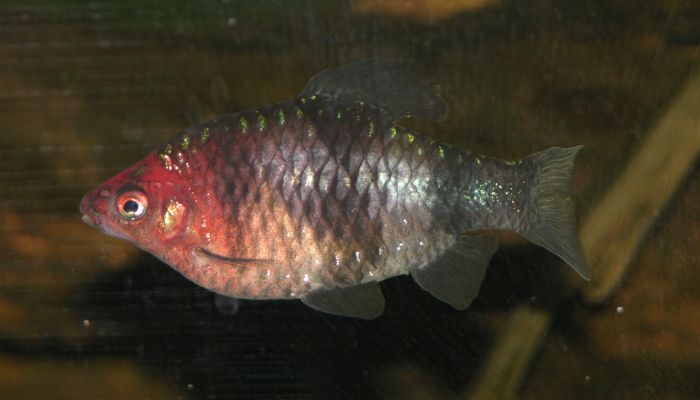- Black ruby barb
Taxobox
name = Black ruby barb
status = LR/cd | status_system = IUCN2.3

image_width = 250px
regnum =Animal ia
phylum = Chordata
classis =Actinopterygii
ordo =Cypriniformes
familia =Cyprinidae
genus = "Puntius "
species = "P. nigrofasciatus"
binomial = "Puntius nigrofasciatus"
binomial_authority = (Guenther,1868 )
synonyms ="Barbus nigrofasciatus" (Guenther, 1868)The black ruby barb ("Puntius nigrofasciatus") or purplehead barb is a
tropical fish belonging to theminnow family (Cyprinidae ). Originating fromSri Lanka in forested streams from theKelani basin to theNilwala basin, they are found in streams on hills around 1000 ft (300 m) in elevation. The brightly colored population introduced to Mahaweli at Ginigathena, Sri Lanka are said to have diminished in number due to the aquarium export trade. It was originally named "Barbus nigrofasciatus".The young fish has a yellowish gray body with black vertical stripes. The silver body turns into a dark ruby red color in mature, breeding males. In the female, the basal part of all the vertical fins are black. In the male, the whole dorsal fin is a deep black, the anal fin blackish red, and the pelvic fins are reddish. The fish will grow to a maximum length of 2–3
inch es (6–8 centimeters) with the female being slightly longer than the male.Black ruby barbs natively live in a
tropical climate among cool, shady quietly-flowing forested streams with either gravel or sand substrates. Their diet mainly consists of filamentousalgae and detritus. They prefer water with a 6.0–6.5pH , a water hardness of 5–12dGH , and a temperature range of 72–79 °F (22–26 °C).The fish has commercial importance in the aquarium hobby, and are successfully bred in captivity. They are also used to create hybrid forms of "
tiger barb s" for the aquarium trade.An egg-scatterer, the fish spawn more than 100 eggs in shallow water among the plants. The eggs hatch in 1 to 2 days and then will be free-swimming after 24 hours.
In the aquarium
Plenty of room should be provided for this fish, with plenty of light with a shallow covering of floating plants and ample vegetation (half to two-thirds of the tank area). A layer of
humus should be left on the bottom. This species is good for keeping with other barbs and similar fish. In captivity, the fish are omnivorous, with a healthy appetite.ee also
*
List of freshwater aquarium fish species References
*ITIS|ID=163644|taxon=Barbus nigrofasciatus|year=2004|date=April 28
*IUCN|author=Pethiyagoda, R|title=Puntius nigrofasciatus|year=1996|ID=18895|IUCN_Year=2003
*FishBase_species_alt|ID=6144|taxon=Puntius nigrofasciatus|year=2006|month=February
*cite book | editor = Michael K. Oliver | title = Simon & Schuster's Guide to Freshwater and Marine Aquarium Fishes | location= New York, New York | publisher=Simon & Schuster, Inc. | year = 1977 | pages = page 50 | id = ISBN 0-671-22809-9
Wikimedia Foundation. 2010.
